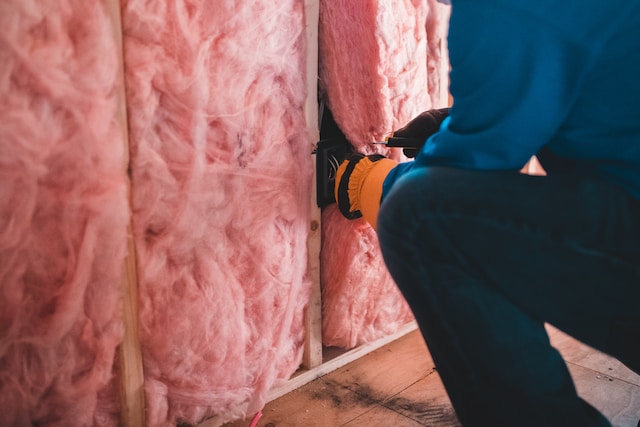
Insulating your home is essential to make your home energy efficient and comfortable. Many types of insulation are available, each with its advantages and disadvantages. This article will examine different types of insulation, their pros and cons, and how to choose the right one for your home. By understanding the options available, you can ensure you get the maximum benefit from your drawbacks while minimizing potential cons.
Background Of Home Insulation
Home insulation has been used for centuries to warm homes in colder climates. In the past, natural materials such as sheep’s wool, straw, and sawdust were commonly used. Today, however, there are many more options available that offer improved efficiency and performance. Common types of insulation now include fiberglass, cellulose, mineral wool, foam, and more.
Types Of Insulation
1. Fiberglass Insulation
Fiberglass insulation is made from spun glass fibers and is the most popular insulation used in homes. It can insulate walls, floors, ceilings, and attics. It’s readily available, cost-effective, and versatile, making it an excellent choice for many applications.
The pro of fiberglass insulation is its high R-value, which means it provides excellent thermal protection. It also does not promote mold growth or attract insects. The cons of fiberglass insulation are that it can irritate the skin and eyes and must be installed properly to ensure maximum efficiency.
2. Cellulose Insulation
Cellulose insulation comprises recycled paper fibers and has become increasingly popular in recent years. It’s fire-resistant, environmentally friendly, and can be installed anywhere, including walls, attics, and floors.
One of the advantages of cellulose insulation is that it is fire-resistant and doesn’t promote mold growth. It also has a higher R-value than fiberglass insulation, providing better thermal protection. The downsides of cellulose insulation are that it can be challenging to install correctly and may not fit tight against walls or other areas where air could escape.
3. Mineral Wool Insulation
Mineral wool insulation is made from melted rock and slag, making it much denser than fiberglass or cellulose. It’s usually used to insulate walls and attics but can also be used on floors and ceilings.
It is non-combustible, making it an excellent choice for fire safety. It’s also mold-resistant and doesn’t attract insects. The downside of mineral wool insulation is that it can be an irritant and potentially a health hazard when inhaled.
4. Foam Insulation
Foam insulation is usually made from polyurethane or polystyrene and is available in closed-cell and open-cell forms. It’s an effective choice for insulating walls, attics, ceilings, and floors.
It improves air sealing, reduces noise, and provides excellent thermal protection. The downside of foam insulation is that it can be challenging to install correctly, and some forms may need to be more eco-friendly.
Homeowners are looking for spray foam kits that offer easy application and high performance to enhance their home’s energy efficiency. These kits are a convenient solution for sealing cracks and gaps, ensuring better insulation and reduced energy costs over time.
5. Spray Foam Insulation
Spray foam insulation is a type of foam that is sprayed directly onto surfaces. It is one of the most efficient types of insulation and can be used to insulate walls, attics, floors, and ceilings.
The main advantage of spray foam insulation is its excellent thermal protection and air sealing. It also expands to fill gaps and cracks, making it an ideal choice for any area where air could escape. The downside of spray foam insulation is that it can be challenging to install correctly and is more expensive than other options.
Properly installed insulation can help keep your home warm in winter and cool in summer and reduce energy bills. Find out more with iFoam. They can help you choose the most suitable type of insulation for your home and ensure its proper installation.
Choosing The Right Type of Insulation
When choosing the right type of insulation for your home, there are many factors to consider. Cost, availability, fire safety, and energy efficiency are all important considerations to keep in mind. It’s also essential to make sure you choose an insulation type suitable for the specific application, as some classes may work better than others in certain areas of the home.
Ultimately, however, the best way to determine which type of insulation is right for you is to speak with a professional and get their advice. They can help you make an informed decision based on your needs and requirements.
Installation Process Of Home Insulation
Once you’ve chosen the correct type of home insulation, you’ll need to have it professionally installed. This process can vary slightly depending on the kind of insulation and where it’s being installed, but it generally follows the same steps.
First, the area will be inspected for potential hazards or problems. Next, the correct size and type of insulation will be fitted into place. This step must be done correctly. Finally, gaps or cracks in walls and ceilings will be sealed. This step must be done correctly.
Installing insulation properly ensures your home is energy efficient and comfortable year-round. It’s important always to hire a professional to install insulation, as incorrect installation can be dangerous and reduce the efficiency of your insulation.
Final Thoughts
Home insulation is an essential part of creating a comfortable, energy-efficient home. Many types of insulation are available, and choosing the right one can be overwhelming. Speaking to a professional who can help you make an informed decision based on your individual needs and requirements is essential.
With the right kind of insulation, you can enjoy a warm and comfortable home all year round! Once the correct type of insulation has been chosen, it must be properly installed for maximum efficiency. A professional installation service should always be used to ensure that the job is done correctly and safely.



